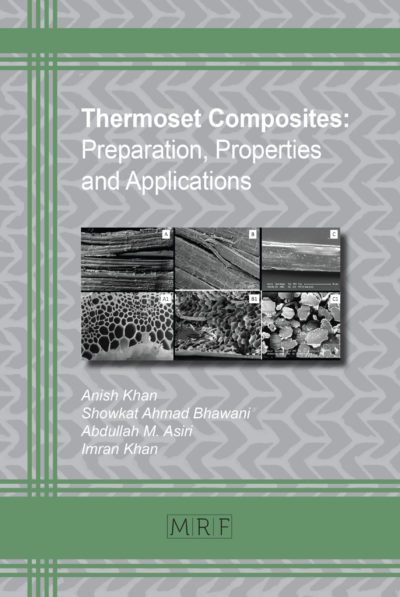Sheet Molding Compound with highly aligned fiber reinforcement: An experimental investigation
Elias Gall, Sergej Ilinzeer, Frank Henning
Abstract. This paper presents a method for aligning chopped glass fibers during SMC production on an SMC-line, using a vibrating gate to obtain a preferential fiber orientation in the semi-finished material. The vibrating gate consisted of multiple blades with varying height and relative distance, resulting in multiple slit configurations. Processing parameters of this test setup were varied in an experimental study to determine the effects on the resulting fiber orientation. Digital image analysis was used to quantify the degree of fiber orientation in the semi-finished material, and in the molded SMC plates produced thereof. In addition to that, tensile strength and modulus were characterized in dependance of load direction following DIN EN ISO 527. Material anisotropy was also characterized with a non-destructive test method using tensile discs. It was found that the chosen process approach was suitable to achieve a preferential fiber orientation, with the blade distance being the most influential parameter on fiber alignment. Highest fiber alignment results were achieved with a configuration with 5 mm relative distance between blades: (a) A fiber fraction of 45% was achieved within 0° ± 20°, (b) in the 0° orientation, tensile strength was doubled, and modulus was increased by 55% compared to a reference SMC with random fiber distribution.
Keywords
Composites, SMC, Glass Fiber, Fiber Alignment
Published online 5/7/2025, 10 pages
Copyright © 2025 by the author(s)
Published under license by Materials Research Forum LLC., Millersville PA, USA
Citation: Elias Gall, Sergej Ilinzeer, Frank Henning, Sheet Molding Compound with highly aligned fiber reinforcement: An experimental investigation, Materials Research Proceedings, Vol. 54, pp 497-506, 2025
DOI: https://doi.org/10.21741/9781644903599-54
The article was published as article 54 of the book Material Forming
![]() Content from this work may be used under the terms of the Creative Commons Attribution 3.0 license. Any further distribution of this work must maintain attribution to the author(s) and the title of the work, journal citation and DOI.
Content from this work may be used under the terms of the Creative Commons Attribution 3.0 license. Any further distribution of this work must maintain attribution to the author(s) and the title of the work, journal citation and DOI.
References
[1] AVK – Industrievereinigung Verstärkte Kunststoffe e. V., Ed. 2013. Handbuch Faserverbundkunststoffe/Composites. Springer Fachmedien Wiesbaden, Wiesbaden.
[2] Barnett, P. R. and Ghossein, H. K. 2021. A Review of Recent Developments in Composites Made of Recycled Carbon Fiber Textiles. Textiles 1, 3, 433-465. https://doi.org/10.3390/textiles1030023
[3] Beuth Verlag GmbH. 2005. DIN EN 14598-1, Berlin. DOI=10.31030/9598327.
[4] Diestel, O. and Hausding, J. 2011. Vorimprägnierte textile Halbzeuge (Prepregs). In Textile Werkstoffe für den Leichtbau, C. Cherif, Ed. Springer, Berlin, 381-399. https://doi.org/10.1007/978-3-642-17992-1_11
[5] Dommes, H. 2010. Vom Faserabfall zum hochwertigen Leichtbau-Halbzeug: CFK-Organofolie. Lightweight Design 3, 5, 23-27. https://doi.org/10.1007/BF03223621
[6] Gan, K. W., Ho, Y. W., Ow, Z. Y., Israr, H. A., and Wong, K. J. 2019. Aligned discontinuous carbon fibre tows in hybrid composites and their tensile behaviour: An experimental study. Journal of Composite Materials 53, 26-27, 3893-3907. https://doi.org/10.1177/0021998319849697
[7] Harper, L. T., Turner, T. A., Martin, J., and Warrior, N. A. 2009. Fiber Alignment in Directed Carbon Fiber Preforms. Journal of Composite Materials 43, 1, 57-74. https://doi.org/10.1177/0021998308098151
[8] Henning, F., Drechsler, K., and Chatzigeorgiou, L. 2020. Faserverstärkte Kunststoffe. In Handbuch Leichtbau: Methoden, Werkstoffe, Fertigung, F. Henning and E. Moeller, Eds. Hanser, München, 335-379. https://doi.org/10.3139/9783446459847.014
[9] Henning, F. and Moeller, E., Eds. 2020. Handbuch Leichtbau: Methoden, Werkstoffe, Fertigung. Hanser, München. https://doi.org/10.3139/9783446459847.fm
[10] Liu, Z., Turner, T. A., Wong, K. H., and Pickering, S. J. 2021. Development of high performance recycled carbon fibre composites with an advanced hydrodynamic fibre alignment process. Journal of Cleaner Production 278, 123785. https://doi.org/10.1016/j.jclepro.2020.123785
[11] Liu, Z., Wong, K., Thimsuvan, T., Turner, T., and Pickering, S. 2015. Effect of fibre length and suspension concentration on alignment quality of discontinuous recycled carbon fibre. In 20th International Conference on Composite Materials, ICCM 2015.
[12] Longana, M. L., Ong, N., Yu, H., and Potter, K. D. 2016. Multiple closed loop recycling of carbon fibre composites with the HiPerDiF (High Performance Discontinuous Fibre) method. Composite Structures 153, 271-277. https://doi.org/10.1016/j.compstruct.2016.06.018
[13] Manis, F., Stegschuster, G., Wölling, J., and Schlichter, S. 2021. Influences on Textile and Mechanical Properties of Recycled Carbon Fiber Nonwovens Produced by Carding. Journal of Composites Science 5, 8, 209. https://doi.org/10.3390/jcs5080209
[14] Orgéas, L. and Dumont, P. J. J. 2012. Sheet Molding Compounds. In Wiley Encyclopedia of Composites. Wiley, 1-36. DOI=10.1002/9781118097298.weoc222. https://doi.org/10.1002/9781118097298.weoc222
[15] Papthanasiou, T. D. 2022. Flow-Induced Alignment in Composite Materials. Woodhead Publishing Series in Composites Science and Engineering Ser. Elsevier Science & Technology, San Diego.
[16] Plinke, B., Dix, B., Andrä, H., Schneider, M., and WKI, F. 2017. MDF Faserorientierung.
[17] 2022. Saechtling Kunststoff-Handbuch. Hanser, München.
[18] Schürmann, H. 2005. Konstruieren mit Faser-Kunststoff-Verbunden. VDI. Springer, Berlin https://doi.org/10.1007/b137636
[19] Such, M., Ward, C., and Potter, K. 2014. Aligned discontinuous fibre composites: a short history. J. Multifunct. Compos 2, 3, 155-168. https://doi.org/10.12783/issn.2168-4286/2/3/4/Such
[20] Teschner, R. 2019. Glasfasern. Springer Berlin Heidelberg, Berlin, Heidelberg.
[21] Tinevez, J.-Y. 2018. Directionality plugin for ImageJ. https://imagej.net/plugins/directionality. Accessed 30 April 2024.
[22] Tröster, S. 2003. Materialentwicklung und-charakterisierung für thermoplastische Faserverbundwerkstoffe im Direktverfahren, Universität Stuttgart.
[23] Woidasky, J. 2020. Recyclingfähigkeit und End-of-Life-Konzept im Leichtbau. In Handbuch Leichtbau: Methoden, Werkstoffe, Fertigung, F. Henning and E. Moeller, Eds. Hanser, München, 1141-1160. https://doi.org/10.3139/9783446459847.041
[24] Wong, K. H., Turner, T. A., Pickering, S. J., and Warrior, N. A. 2009. The potential for fibre alignment in the manufacture of polymer composites from recycled carbon fibre. SAE International journal of Aerospace 2, 2009-01-3237, 225-231. https://doi.org/10.4271/2009-01-3237
[25] Yu, H., Potter, K. D., and Wisnom, M. R. 2014. A novel manufacturing method for aligned discontinuous fibre composites (High Performance-Discontinuous Fibre method). Composites Part A: Applied Science and Manufacturing 65, 175-185. https://doi.org/10.1016/j.compositesa.2014.06.005













